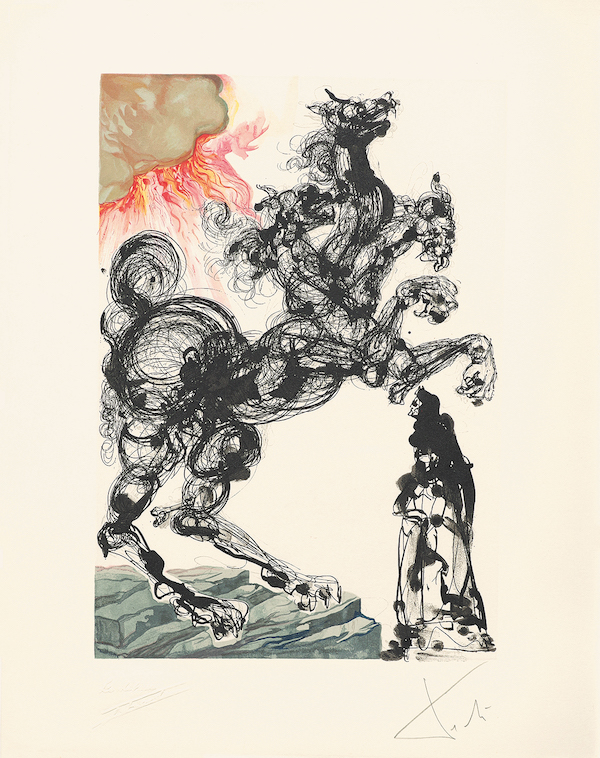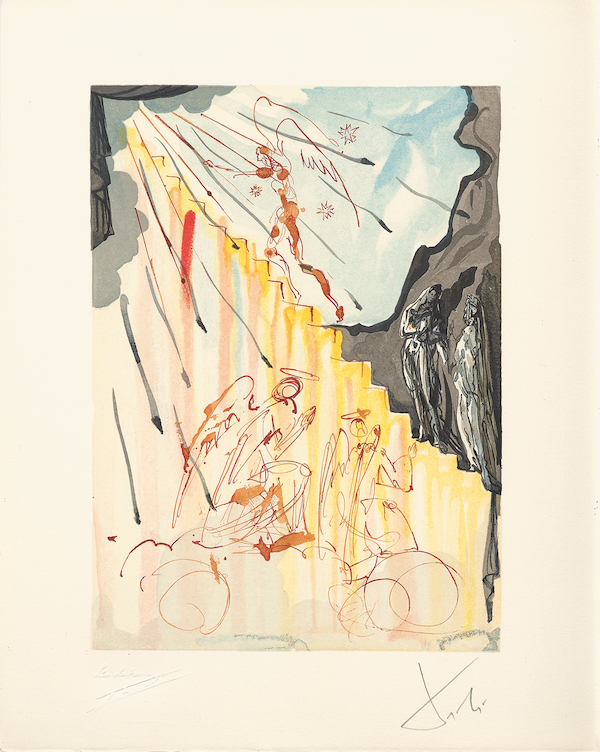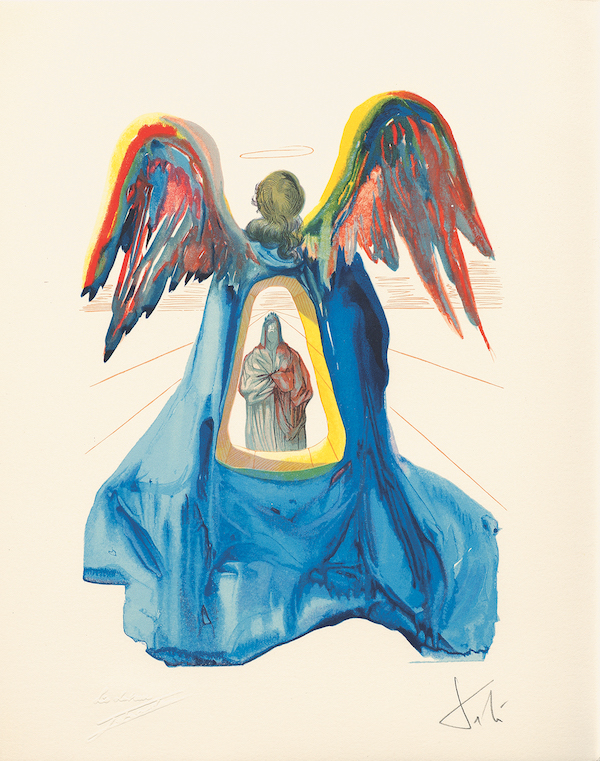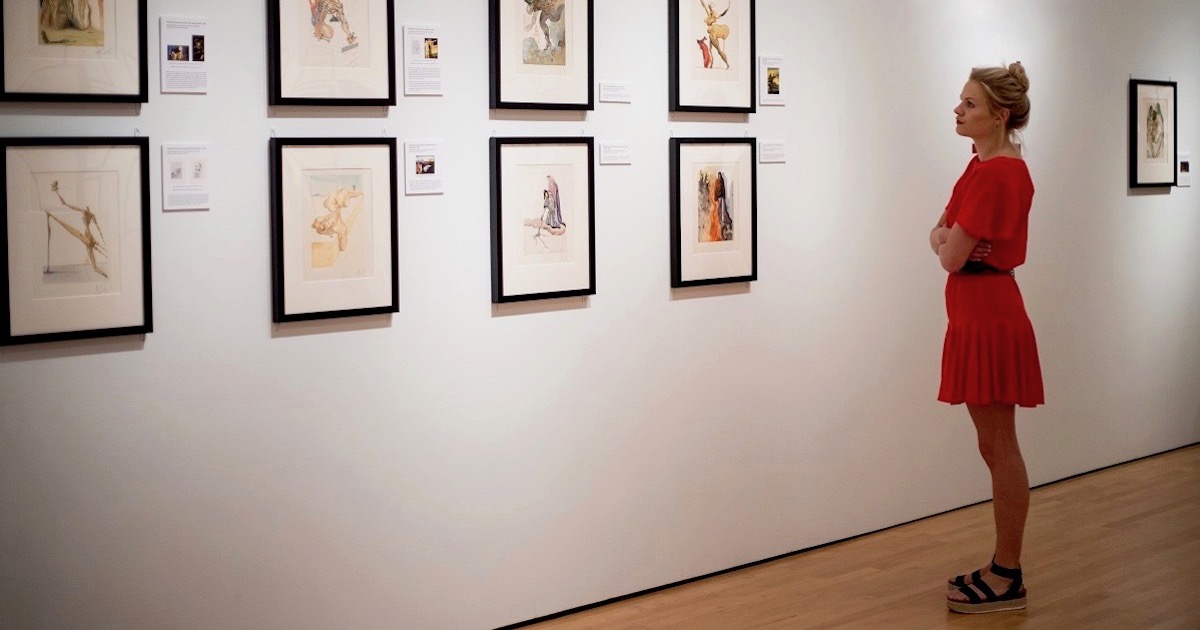Salvador Dalí was an enigma, perhaps never more so than in his engagement with religion. An exhibition currently touring the US demonstrates the divided and dualistic nature of that relationship. ‘Salvador Dalí’s Stairway to Heaven,’ features complete portfolios of Dalí’s illustrations for two of his most ambitious publishing projects—his artwork for memorable editions of Comte de Lautréamont’s ‘Les Chants de Maldoror’ and Dante’s ‘The Divine Comedy’.
By the 1950s, Salvador Dalí had renounced Surrealism and embraced Catholicism
Each project comes from a different era in Dalí’s life. ‘Les Chants de Maldoror’, was an 1869 text rediscovered by the Surrealists in the 1930s. Dalí completed his 43 illustrations when he was still proudly identifying as a Surrealist. The poetic non-linear novel concerns a man who had denounced God, humanity, and conventional morality. At the time, the subject matter – scenes of violence, perversion, and blasphemy – was ideal for Dalí.

Salvador Dalí proclaimed himself ‘a Surrealist void of all moral values’ during his stay in Paris in 1929 with the Surrealist group presided over by André Breton. Also in 1929, to the anger and distress of his family, he drew a controversial image of Christ and the sacred heart, which he entitled ‘Sometimes I spit with pleasure on the portrait of my mother (The Sacred Heart)’. His ‘Profanation of the Host’ followed in 1930, with several other sacrilegious connotations.
In ‘Diary of a Genius’, Dalí wrote that Nietzsche’s ‘Thus Spoke Zarathustra’ drove him to atheism and the rejection of Christian virtues, contributing to the development of his anti-social instinct and lack of family feeling. Magdalena Scholle notes that, for Dalí, the four years before his exclusion from his family were a state of extreme ‘spiritual subversion’: ‘To me, those years were truly Nietzschean.’
When Dalí illustrated Dante Alighieri’s ‘The Divine Comedy’ two decades later, he was a very different man. By the 1950s, he had renounced Surrealism and embraced Catholicism. Thus, Dante’s story of a man traversing the levels of Hell, Purgatory, and Paradise held special meaning for him.
Matthew Milliner suggests that, in the Inferno paintings, ‘Salvador Dalí’s famously contorted explorations finally find a proper context, enabling his works to progress from titillating suggestion to actual communication.’ Here, ‘the bending and blending of reality is not the revolt against bourgeois rationality that his fellow Surrealists wished such arrangements to be—a truncated vision; instead, they represent rebellion against the created order, that is, Inferno.’ Again, the illustrations of Purgatorio, mirroring Dalí’s artistic path, ‘sport a newfound cohesion.’ ‘The fire of Dalí’s undeniable talent once burned recklessly,’ he writes, ‘but here glows in the hearth of Christian tradition.’
In seeking to document the nature of this change, W. Alan Smith writes that: ‘Dalí’s attitude toward Roman Catholicism began to change as early as 1941, and his painting began to reflect an intentional dialogue with his Christian roots. During his emigration to the United States during World War II, he began to envision a fusion of Science and traditional elements of the Christian faith. The result of this mix of influences was the development of a new approach to painting and personal theology/ philosophy he branded as “Nuclear mysticism.”
Tim McNeese suggests that: ‘There was more to Dalí’s greater reliance on matters of faith than simply for metaphysical expression, however. He was turning to the Catholic Church itself. In 1949, he made the first of two visits to Rome to see Pope Pius XII. In Rome, he studied religious art closely … Teilhard de Chardin, whose ideas concerning religion fascinated Dalí, even though they were, at the time, controversial. Then, his father died in 1950. All these influences drew Dalí into the realm of the spiritual, and his paintings soon included religious subjects.’
Various claims are made for the moment of Dalí’s conversion. Michael Anthony Novak states that Salvador Dalí returned to the Catholic faith in 1949. That was when Dalí attended his first private audience with Pope Pius XII and presented the Pope with the first version of his work ‘Madonna of Port Lligat’. He then, later, announced his return to the Catholic Church.
During a visit to Avila, Spain in 1950 he gained access to the journals of the16th-century Spanish mystic, St. John of the Cross and viewed a sketch of the crucified Christ the saint had drawn. This experience led to what Dalí described as a ‘cosmic dream’ resulting in his famous painting ‘Christ of St. John of the Cross’.
Dalí later described this experience: ‘In the first place, in 1950, I had a “cosmic dream” in which I saw this image in colour and which in my dream represented the “nucleus of the atom.” This nucleus later took on a metaphysical sense; I considered it ‘the very unity of the universe,’ the Christ! In the second place, when, thanks to the instructions of Father Bruno, a Carmelite, I saw the Christ drawn by Saint John of the Cross, I worked out geometrically a triangle and a circle that aesthetically summarised all my previous experiments, and I inscribed Christ in the triangle.’

In 1960 he was commissioned by The Blue Army of Our Lady of Fatima to paint the Vision of Hell, as Francisco de Jesus Marto, Jacinta de Jesus Marto and Lúcia dos Santos experienced it during their July 13, 1917, apparition at Fatima. Dalí visited Fatima, met Sister Lúcia – commenting on how special it felt to ‘breath the same air as a future saint’ – and made his confession to Canon Jose Galamba de Oliveira, his guide; ‘the most moving, sincere and profound confession’ Galamba had ever heard in his many decades as a priest.
Then, in 1963, Dalí’s friend and patron, Dr Giuseppe Albaretto, commissioned Dalí to create illustrations for a new edition of the Bible. The Biblia Sacra lithographs were commissioned, as Albaretto stated in an interview in 1995, to persuade Dalí to ‘meditate on the Catholic religion’ and lead the artist to a closer relationship with God.
Dalí himself made statements to the effect that belief in God was evident from Science but that he himself struggled to believe. In his 1942 autobiography he wrote:
‘One thing is certain: nothing, absolutely nothing, in the philosophic, aesthetic, morphological, biological or moral discoveries of our epoch denies religion. On the contrary, the architecture of the temple of the special sciences has all its windows open to heaven.
Heaven is what I have been seeking all along and through the density of the confused and demoniac flesh of my life — heaven! Alas for him who has not yet understood that! The first time I saw a woman’s depilated armpit, I was seeking heaven. When with my crutch, I stirred the putrefied and worm-eaten mass of my dead hedgehog; it was heaven I was seeking. When from the summit of the Muh de la Torre, I looked far down into the black emptiness, I was also and still seeking heaven! Gala, you are reality! And what is heaven? Where is it to be found? Heaven is to be found, neither above nor below, neither to the right nor to the left, heaven is to be found exactly in the centre of the bosom of the man who has faith! At this moment, I do not yet have faith, and I fear I shall die without heaven.’
In 1950, he gave a lecture at the Ateneu in Barcelona, titled ‘Why I was Sacrilegious. Why I am a Mystic’ which sought to explain his transformation from a zealous anti-cleric to a devout Catholic albeit one who lacked complete ‘faith’: ‘I believe in God, but I have no faith. Mathematics and Science tell me that God must exist, but I don’t believe it.’ He attempted to persuade his audience not only that his Catholic imagery was the work of a sincere believer, but also that he was, in fact, a true religious mystic, informed by the latest scientific advancements.
Mysticism was the unusual weapon that he had at his disposal to help ‘penetrate to the core of reality.’ Mysticism is ‘the profound intuitive knowledge of what is, direct communication with the all, absolute vision by the grace of Truth, by the grace of God.’ He claimed that, ‘By reviving Spanish mysticism I, Dali, shall use my work to demonstrate the unity of the universe, by showing the spirituality of all substance.’
Towards the end of 1951’s ‘Mystical Manifesto,’ he declared: ‘Finished are the denials and demotions, finished the Surrealist malaise and existentialist anxiety. Mysticism is the paroxysm of joy in the ultra-individualist affirmation of all man’s heterogeneous tendencies within the absolute unity of ecstasy. I want my next Christ to be a painting containing more beauty and joy than anything that will have been painted up to the present. I want to paint a Christ that will be the absolute contrary in every respect to the materialist and savagely antimystical Christ of Grünewald!’
Amidst these confusions and contentions, Salvador Dalí created some of the most popular yet controversial religious paintings of the twentieth century; ‘The Sacrament of the Last Supper’, from 1955, being one example. Theologian Paul Tillich considered the work’ junk’ and said he was horrified by the depiction of Jesus as ‘A sentimental but very good athlete on an American baseball team.’ By contrast, both Paul Myhre and Michael Novak identified the Eucharistic character of the painting as an answer to the many theological critics who have reviled it. Novak claimed, ‘Dalí gives us the real presence of Christ in the Eucharist.’

How to understand this degree of contestation and confusion? I want to suggest that Dalí himself provides a means to understand through his two key concepts of the paranoiac-critical analysis method and Nuclear-Mysticism. The paranoiac-critical method offers us objects that turn into other objects or images which, when observed anew become another image. Double images reveal surface content and shadow content; a both/and. Dalí was concerned with fusion. The point being that, for Dalí, there was no either-or, both are valid at one and the same time; that is fusion. Dalí’s experience of religion was divided from the off, as his mother’s family were devout Catholics, but his father was a staunch atheist. His solution is to fuse both – as alternating surface and shadow, Maldoror and Dante – rather than to choose and divide. His Nuclear Mysticism is, therefore, an extension of this decision; fusing Science and religion, physics and mysticism.
His Nuclear Mystical paintings build visually on the use of Aeropainting in Futurist Sacred Art between 1920 and 1940, the period in which Dalí was returning to Catholicism, and theologically on Teilhard de Chardin’s writings regarding the Cosmic Christ. Massimo Duranti has explained how elevated perspectives in Futurist Sacred Art through Aeropainting’ reinforced the concept of the spiritualization of matter with reference to the environment and the cosmos.’ Susan Rakoczy notes that de Chardin ‘developed a unique synthesis of science and religion based on an evolutionary understanding of what he called the ‘cosmic Christ’ – the idea that the universe and everything in it is constantly moving towards to a point of perfection defined by unity and love.’ De Chardin’ profoundly absorbed the Ignatian vision of “finding God in all things” and extended it to the furthest reach of the cosmos.’ In his book ‘The Divine Milieu’ he wrote, ‘To repeat, by virtue of the Creation, and still more, of the Incarnation, nothing here below is profane to those who know how to see.’
Dalí builds on these developments to provide a counter-balance to modern depictions of the crucifixion, which primarily draw inspiration from Matthias Grünewald’s Isenheim altarpiece and are predominantly expressionist in style. Dalí’s reaction – Christ’s that are the absolute contrary in every respect to the materialist and savagely antimystical Christ of Grünewald – provides images that are beautiful, classical and cosmic.
W. Alan Smith argues that during ‘the ‘classical’ period of his work, Salvador Dalí entered into dialogue with nuclear physics, Watson and Crick’s discoveries in DNA research, a re-discovery of the glories of Renaissance painting, and a renewed appreciation for traditional Roman Catholic claims about the Eucharist, the Resurrection, and the Assumption of Mary that truly honoured those doctrinal claims as others whose voices he felt compelled to honour and engage with.’ What resulted from this commitment, he argues, is a new claim to truth and meaning. Not only was Dalí’s artwork changed dramatically ‘as a result of his dialogue with the multiple partners of his wild intellectual journey’ but Dalí himself was transformed – as an artist and as a person.’ Smith concludes that: ‘His commitment to dialogue and his willingness to listen to the voices of the numerous others who served as his dialogue partners allowed his fertile imagination to push the understanding of art as well as science and theology in such a way that anyone ‘with eyes to see’ could not help but see the world and its God more clearly – and, with Dalí, much differently than it could without his unique artistic and spiritual voice.’
‘Salvador Dalí Stairway to Heaven’: Plains Art Museum (Fargo, North Dakota): December 19, 2019 – May 20, 2020; (lockdown permitting) Fort Wayne Museum of Art (Fort Wayne, Indiana): June 13, 2020 – August 16, 2020; Mabee-Gerrer Museum of Art (Shawnee, Oklahoma): September 11, 2020 – November 1, 2020; Biggs Museum of American Art (Dover, Delaware): December 4, 2020
Read More About Salvador Dalí
Visit Salvador Dalí Exhibition On Line

